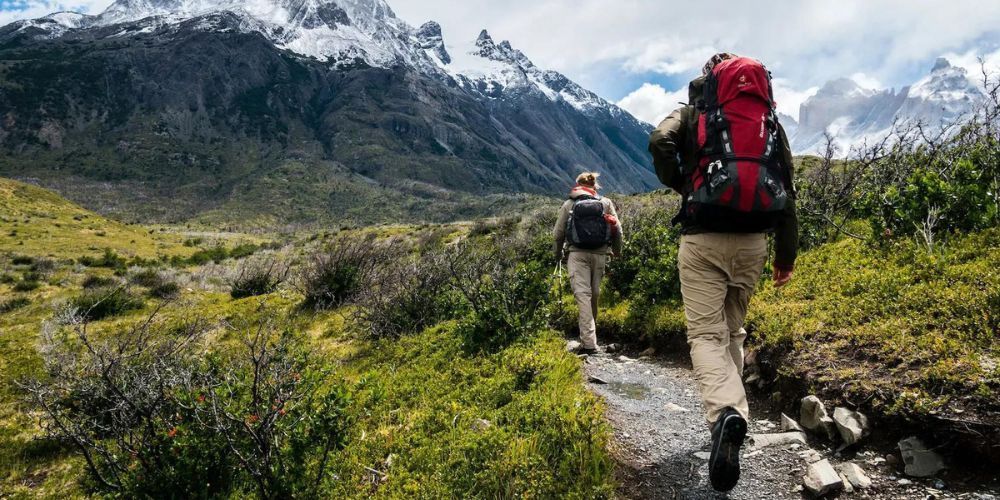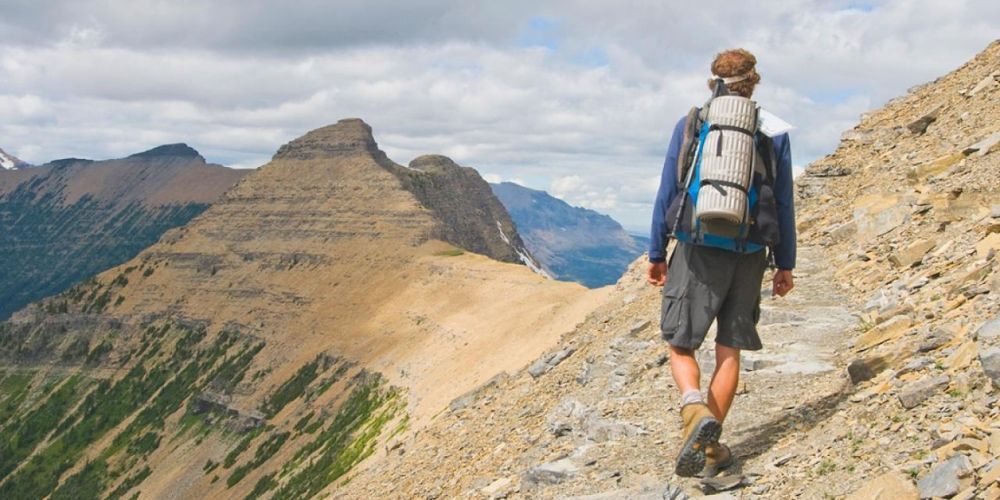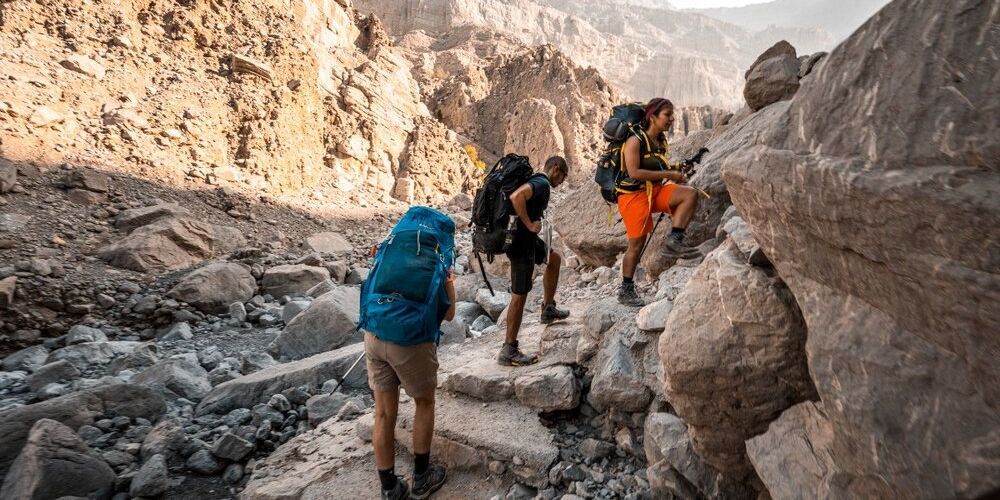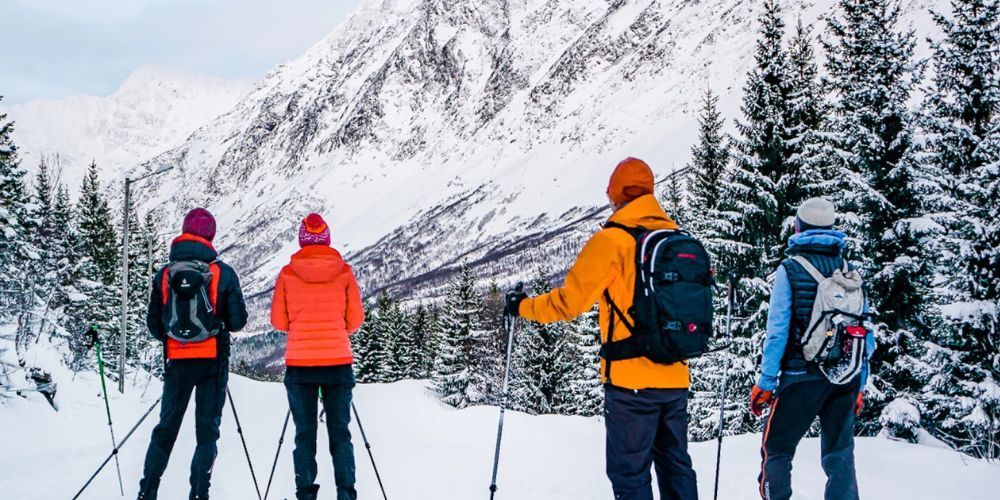Essential Gear for Long-Distance Hikers: The Ultimate Backpacking Equipment Guide
July 27, 2024
There's a fine line between an exhilarating adventure and an ordeal when it comes to long-distance hiking. The secret? The right gear to ensure you're prepared for anything Mother Nature throws your way. On countless trails, I've learned just how vital it is to balance durability, weight, and functionality in every item I pack.
Consider this guide as your trail companion—hours of research combined with firsthand insights from seasoned hikers who have faced everything from unexpected snowstorms to dehydrating heatwaves. Each piece of gear listed here has been carefully chosen based on expert reviews and real-life experiences. Think of equipping yourself as preparing for an expedition; every ounce matters, and each tool has a purpose beyond its weight in your backpack. Let's dive into your essentials for a rewarding journey ahead.
The essential gear for long-distance hiking includes a large
backpack with a rain cover, quick-dry trekking t-shirts, trekking trousers, fleece cardigan, warm padded jacket,
hiking boots, sleeping bag and liner, camping stove with pot and gas cartridge, headlamp, water system with bottle and
filter, maps and compass (if needed), biodegradable camping soap, toilet paper in a waterproof pouch,
first aid kit, freeze-dried meals, hip flask with whisky (if desired), and more. Always consider weight distribution and accessibility when packing your backpack.

Must-Have Gear for Long-Distance Hikes
The success of a long-distance hike often hinges on the gear you bring along. When it comes to backpacking, it's not about having the most expensive equipment; it's about choosing gear that balances durability, weight, and functionality. It's crucial to carefully select the right items to carry with you as they will directly impact your physical comfort, safety, and overall hiking experience. Now, let's explore the key items that every long-distance hiker's pack should include.
Backpack
The backpack is your mobile home during a long-distance hike, storing all your essentials while providing comfort and support for your back. It's important to choose a durable backpack with a capacity of 50-75 liters, allowing space for necessary gear without overburdening yourself with unnecessary weight. Look for features such as multiple compartments, padded shoulder straps, a padded hip belt, and an adjustable suspension system for a customized and comfortable fit.
Shelter
Along the journey, having a reliable shelter is vital for resting and weathering unexpected elements. Whether you prefer the traditional coziness of a lightweight backpacking tent or the minimalistic convenience of a bivy sack, your shelter should be lightweight, weather-resistant, and easily set up. Consider the expected weather conditions and terrain when selecting your shelter to ensure it meets your specific needs.
Sleeping System
A restful night's sleep directly impacts your physical performance the next day. Therefore, investing in high-quality sleeping gear is crucial. Select a sleeping bag rated for the lowest expected temperature on your journey to ensure warmth, complemented with a suitable sleeping pad for insulation from the cold ground.
Hydration System
Proper hydration is non-negotiable during a long-distance hike. Carrying water bottles or hydration reservoirs with a capacity of 2-3 liters ensures you have enough water for the journey. Additionally, including a portable water filter provides a reliable source of clean drinking water in various outdoor settings, minimizing the risk of dehydration or consuming contaminated water.
Did you know? Dehydration can significantly affect physical performance and increase the risk of heat-related illnesses such as heat exhaustion or heatstroke during long-distance hikes.
Navigation Tools
While embracing the natural beauty of diverse landscapes during a long-distance hike, navigation tools become indispensable. Consider carrying physical maps of the terrain along with a reliable compass or GPS device to ensure you stay on course and can accurately estimate travel time and distances.
Cooking Gear
A lightweight stove with compatible fuel, a cooking pot appropriate for trail meals, and utensils are essential components of your cooking gear. These items not only provide hot meals but also boost morale after a long day on the trail. Select lightweight options that efficiently cook meals while conserving precious fuel.
First Aid Kit
A well-stocked first aid kit is paramount for handling potential injuries or emergencies on the trail. Ensure it includes bandages, antiseptic ointment, any personal medications needed, as well as emergency items like adhesive tape and a whistle for signaling distress in remote areas.
Lighting
When darkness falls, reliable lighting becomes invaluable. Opt for headlamps equipped with extra batteries to illuminate paths and perform campsite tasks during low-light conditions.
Multi-tool
Think of this as your "Swiss Army Knife" for outdoor adventures - versatile and indispensable. A multi-tool assists in minor gear repairs and other unexpected situations that may arise during your hiking journey—it's worth its weight in gold in terms of practicality and preparedness.
By carefully curating these essential items in your pack, you'll greatly enhance your comfort, safety, and readiness throughout your long-distance hike. Each piece serves as an integral part of your gear collection, contributing to an enjoyable and successful adventure on the trail.Now that we've covered the fundamental gear essentials for long-distance hikes, let's turn our attention to delving into another critical component: choosing the perfect backpack.
Choosing the Perfect Backpack
When selecting the ideal backpack for a long-distance hike, several crucial factors come into play, ensuring it suits your needs perfectly. One of the most critical considerations is size and capacity.
The size and capacity of the backpack play a significant role in making sure that you can comfortably carry all your essentials without overburdening yourself. A backpack with a capacity of about 50-75 liters is generally recommended for long-distance hikes, providing ample space to carry your gear while still maintaining manageable weight distribution.
Moving on to fit and comfort, it's essential that your backpack fits your torso length and has adjustable straps to ensure a snug and comfortable fit. Many brands even offer gender-specific models, designed to enhance comfort by accommodating differences in body shape and build. This tailored fit not only improves comfort but also reduces the risk of developing blisters and sores, guaranteeing a more pleasant hiking experience overall.
Apart from fit and capacity, additional features should also be taken into account when selecting your backpack. Look for a backpack with multiple compartments for easy organization of your gear, as well as an internal frame that helps distribute weight evenly across your back. Hydration system compatibility is another essential feature to look for, especially if you prefer staying hydrated on the go. Furthermore, a built-in rain cover can provide added protection for your gear during unexpected downpours, ensuring that your belongings remain dry and secure.
By carefully considering these factors – size and capacity, fit and comfort, and additional features – you can identify a backpack that will serve as a reliable companion on your long-distance hiking adventures. The right backpack will not only make carrying your essentials more manageable but also contribute to a more enjoyable and comfortable journey overall.
With the perfect backpack in tow, the next critical piece in the long-distance hiking puzzle is securing the optimal footwear for tackling tough trails.

Optimal Footwear for Tough Trails
As you set out on a long-distance hiking adventure, your choice of footwear becomes crucial. The right pair of hiking shoes can make all the difference in keeping you comfortable and agile while trekking through diverse terrains. Let's break down some key considerations when it comes to selecting the best hiking footwear for your journey.
Types of Footwear
When it comes to footwear for long-distance hiking, there are primarily two main options: hiking boots and trail runners. Hiking boots provide excellent ankle support, making them ideal for navigating rough, uneven terrain and providing added protection against potential ankle twists or injuries. Conversely, trail runners are a lighter, more flexible option, suitable for smoother paths and well-groomed trails. Their reduced weight enables faster movement, making them an optimal choice for fastpacking or less demanding terrain.
If you're going to be covering rugged terrain with a heavy pack, investing in a sturdy pair of hiking boots is often a wise decision. They provide extra stability and support to help you tackle rocky, uneven ground with confidence. On the other hand, if you're planning a fast-paced, lightweight adventure over relatively milder trails, trail runners offer a nimble and responsive alternative.
Fit and Comfort
The comfort and fit of your hiking footwear are non-negotiable factors that directly impact your hiking experience. It's essential to prioritize shoes that provide ample room for your toes, especially during descents where your toes may slide forward repeatedly. Additionally, ensure that the shoes don't cause blisters when broken in—this can be achieved by selecting boots or trail runners that fit snugly without feeling overly tight.
Remember, every foot is unique, so take the time to try on different styles and brands to find the best fit for you. Look out for any areas of rubbing or discomfort as these can indicate potential issues once you're out on the trail.
Weather Resistance
While embarking on a long-distance hike, unpredictable weather conditions are simply par for the course. As such, it's vital to invest in footwear that offers reliable weather resistance. Waterproof or water-resistant footwear is essential for keeping your feet dry in wet conditions, preventing discomfort and lowering the risk of developing blisters from prolonged exposure to moisture. However, it's equally important to ensure that your shoes are breathable to prevent excessive sweating—a factor that could lead to discomfort and even potential foot issues.
Imagine trudging through drizzling rain or slogging through muddy terrain—having waterproof or water-resistant footwear will keep your feet dry and comfortable throughout the journey. This level of protection can significantly impact your overall performance and enjoyment on the trail.
By carefully considering these factors when choosing the optimal footwear for your long-distance hikes, you'll be able to enhance your comfort and efficiency on challenging trails while mitigating potential risks associated with ill-fitting or unsuitable shoes. Making informed decisions about your hiking footwear will undoubtedly elevate your overall experience on the trail.

Layering Clothes for Variable Weather
When you're out on the trail, the weather can change rapidly. One moment you're basking in the sun's warmth, and the next, a chilly breeze blows through. This is where strategic layering becomes your best friend. It's not about throwing on all the clothes you own; it's about building a system of clothing that works together to keep you comfortable and protected, no matter what nature throws at you.
Understanding the role of each layer: Your base layer is like a second skin, hugging your body and wicking away sweat to keep you dry and prevent chafing. It's important to choose moisture-wicking materials like synthetic fabrics or Merino wool to ensure your skin stays dry. The insulating layer traps body heat to keep you warm, so a fleece or down jacket is essential for cold conditions. Finally, your shell layer acts as a barrier against wind and rain while letting moisture escape to regulate temperature.
Base Layers
Your skin needs to breathe, especially when exerting yourself on a long hike. This is where the base layer comes in. Moisture-wicking materials like synthetic fabrics or Merino wool are ideal for keeping your skin dry and comfortable, preventing sweat from building up.
Insulating Layers
When temperatures drop, an insulating layer is essential to trap body heat and keep you warm. A good-quality fleece or down jacket will provide the necessary warmth without adding excessive weight or bulk to your backpack.
Shell Layers
Unpredictable weather calls for reliable protection against rain and wind. A waterproof and windproof jacket is a must-have for any hiker, but it's equally important that it's breathable to prevent overheating while allowing moisture to escape.
Accessory Layers
Don't overlook accessories like gloves, hats, and buffs. These items provide extra protection against harsh elements and can be easily removed or added as needed based on the changing weather conditions.
The ability to remove or add layers as needed ensures that you can effectively regulate your body temperature throughout your hike, preventing both overheating and chilling. Additionally, being able to adjust your clothing makes it easier to adapt to changes in weather or activity level while maintaining comfort and performance on the trail.
Understanding how to dress appropriately for variable weather conditions is just the beginning of gearing up for an exhilarating trek. Now, let's explore outfitting for another crucial part of long-distance hiking—finding the best shelter solutions.
Finding the Best Shelter Solutions
When you're out on a long-distance hike, choosing the right shelter solution becomes a crucial decision. The elements can be unpredictable, and finding the right balance between weight, durability, and comfort is essential for a successful backpacking experience. Let's explore some of the best shelter options tailored specifically for long hikes.
Lightweight Tents
If you're considering a tent, it's crucial to find one that strikes the perfect balance between weight and comfort. The Big Agnes Fly Creek HV UL2 is highly regarded for its lightweight design and durability. It offers ample space while still being light enough to carry on extended journeys through diverse terrain.
This lightweight tent is constructed with durable materials that provide reliable shelter in various weather conditions. Its efficient use of space and user-friendly setup make it an ideal choice for backpackers who value both comfort and practicality.
Hammocks
For hikers looking for an alternative to traditional tents, hammocks offer a lightweight and convenient option. However, it's important to note that hammocks require suitable trees or anchor points for setup, which may not always be available depending on your hiking route.
While hammocks provide an excellent way to minimize pack weight, they may not be suitable for all climates. Consider factors such as insect protection, underquilt insulation, and proper rain coverage when choosing a hammock setup for your long-distance hike.
Tarps
Ultralight tarps are versatile shelter options that can provide adequate protection when pitched correctly. When selecting a tarp for your backpacking trip, prioritize durability and proper anchoring systems to ensure stability in varying conditions.
The ultralight nature of tarps makes them an attractive option for hikers seeking to minimize pack weight while maintaining functional shelter coverage. Additionally, their versatility allows for creative pitching arrangements to suit different terrains and weather scenarios.
- Lightweight Tents
- Pros: Balance of weight and comfort
- Cons: Bulkier than other options, but offers more comprehensive protection
- Hammocks
- Pros: Lightweight and versatile
- Conts: Requires suitable anchor points; may not be suitable for all climates
- Tarps
- Pros: Ultralight and versatile
- Cons: Relies on proper anchoring systems; less comprehensive protection
Each of these shelter solutions offers unique advantages suited to specific hiking preferences and environmental conditions. Selecting the right shelter solution ensures that you have a reliable retreat at day's end without compromising your efficiency and comfort during your long-distance trek.
Now, let's turn our attention to the essential items for sustenance on your long hike: food and water essentials.
Food and Water Essentials
As you embark on your long-distance hiking journey, it's crucial to ensure that you have sufficient sustenance and access to clean water. Planning and packing the right food and water essentials are integral to maintaining your energy levels and well-being throughout the trek.
Meeting Caloric Needs
Long hikes require ample energy reserves, making it essential to carry high-calorie foods that provide sustained fuel. Nuts, dried fruits, and energy bars are excellent choices as they pack a punch in terms of calories and are lightweight, making them ideal for carrying in your backpack.
Aim for at least 3,000 calories per day to meet the increased energy demands of long-distance hiking.
When planning meals for your hike, opt for foods that offer a good balance of macronutrients—carbohydrates, proteins, and healthy fats—to keep you fueled throughout the day. Along with the calorie count, consider the nutritional value of the foods you pack. While non-perishable items are convenient for hiking, including a mix of nutritious options ensures that you meet your dietary needs during your excursion.
Selecting Cooking Systems
Compact cooking systems can significantly enhance your meal preparation while conserving valuable resources such as fuel. The Jetboil Flash is a popular choice among long-distance hikers due to its quick boiling times and efficient use of fuel. Its compact design makes it easy to carry, while its rapid boiling capabilities save precious time when you're on the trail.
When selecting a cooking system for your hiking trip, prioritize efficiency without compromising on performance or safety. Consider the ease of use and maintenance, as well as compatibility with different types of fuel. Opting for a reliable and efficient cooking system ensures that you can prepare hot meals and beverages swiftly during your journey without excessive consumption of resources.
Ensuring Water Purification
Access to clean water is paramount during any outdoor adventure, especially for extended hikes where reliable water sources may be scarce or contaminated. Utilizing water purification systems like the Sawyer Squeeze or Katadyn BeFree filters provides an effective means to eliminate harmful bacteria and protozoa from natural water sources. These portable filtration systems allow you to replenish your water supply safely while minimizing the risk of waterborne illnesses.
Prioritize convenience and reliability when selecting a water purification system for your hike. Look for options that are lightweight, easy to use, and capable of filtering a sufficient volume of water to meet your hydration needs. Additionally, consider the durability and maintenance requirements of the filtration system to ensure its longevity throughout your expedition.
Addressing these food and water essentials forms a critical aspect of ensuring that you are well-prepared for the challenges that lie ahead on your long-distance hiking adventure.
Ensuring Safety on the Trail
Hiking in the great outdoors can be exhilarating, but it also comes with inherent risks. To mitigate these risks, it's vital to carry specific gear and be prepared for various contingencies that could arise. Let's explore some essential elements of ensuring safety while hiking long distances.
One of the crucial devices for hikers exploring remote areas is a communication device like the Garmin inReach Mini 2. This compact tool allows hikers to send SOS signals and communicate via satellite, providing a lifeline in case of emergencies. Its capability to function in remote regions enables hikers to access help when faced with unexpected situations such as injuries or getting lost, potentially saving lives and navigating unforeseen challenges on the trail.
In addition to communication devices, it's prudent for hikers to carry emergency kits containing vital items such as fire starters, emergency blankets, and a whistle. These tools can be lifesaving in adverse situations, offering warmth, distress signaling, and the ability to ignite fires for heat or cooking. They form a crucial component of a hiker's contingency plan, enabling them to address unforeseen circumstances and setbacks effectively.
Imagine being out on the trail and encountering local wildlife unexpectedly or facing sudden unfavorable weather conditions. Awareness and preparedness are key aspects of ensuring safety while hiking. Hikers should educate themselves about local wildlife and have strategies in place for encounters and evacuation. For instance, carrying bear spray in bear country is essential for protection, while knowledge of local hazards such as high-altitude conditions or flash floods enables hikers to proactively navigate potential dangers.
Equipping yourself with communication devices, emergency kits, and cultivating awareness and preparedness are crucial steps towards ensuring safety on the trail. These measures offer peace of mind and empower hikers to navigate through unforeseen challenges effectively while enjoying the splendor of nature.
What are the essential items every long-distance hiker should pack?
Packing for a long-distance hike requires careful consideration to ensure you have everything you need without overloading your backpack. Essential items include:
- Backpack: A well-fitted, comfortable backpack with a capacity of 50-70 liters is crucial for carrying all your gear. Look for features like padded straps, a supportive hip belt, and multiple compartments.
- Shelter: A lightweight tent, bivy sack, or hammock with a rainfly is essential for overnight protection from the elements. Choose one that balances weight, durability, and weather resistance.
- Sleeping Bag and Pad: A sleeping bag rated for the expected temperatures and a lightweight sleeping pad for insulation and comfort are vital for a good night’s rest.
- Clothing: Pack moisture-wicking, quick-drying layers, including a base layer, insulating layer, and waterproof outer layer. Don’t forget extra socks, a hat, and gloves for varying weather conditions.
- Footwear: Sturdy, comfortable hiking boots or trail shoes with good ankle support and traction are essential. Break them in before your hike to avoid blisters.
- Food and Cooking Supplies: High-calorie, lightweight foods like dehydrated meals, energy bars, and nuts are ideal. A portable stove, fuel, lightweight cookware, and a reliable water filtration system are also necessary.
- Navigation Tools: A map, compass, and GPS device or smartphone with offline maps are essential for navigating the trail. Carrying a guidebook or trail guide can also be helpful.
- First Aid Kit: A comprehensive first aid kit, including bandages, antiseptic, blister treatment, and any personal medications, is crucial for treating injuries and illnesses on the trail.
- Multi-Tool and Repair Kit: A multi-tool with a knife, scissors, and other useful tools, along with a repair kit for your gear (such as duct tape, sewing kit, and patch kits), can help fix unexpected issues.
- Lighting: A headlamp or flashlight with extra batteries is essential for navigating in the dark or during emergencies.
- Emergency Supplies: Items like a whistle, emergency blanket, and fire-starting materials (matches, lighter, fire starter) are crucial for safety in case of unexpected situations.
How should I choose the right backpack for long-distance hiking?
Choosing the right backpack for long-distance hiking is critical for comfort and functionality. Consider the following factors:
- Fit and Comfort: The backpack should fit your torso length and have adjustable straps to ensure a snug fit. Look for padded shoulder straps and a supportive hip belt that transfers most of the weight to your hips rather than your shoulders.
- Capacity: For long-distance hikes, a backpack with a capacity of 50-70 liters is usually sufficient. This size allows you to carry all essential gear without overloading yourself.
- Weight: The backpack’s weight should be as light as possible without sacrificing durability and comfort. Lightweight materials and design features can reduce the overall weight you need to carry.
- Accessibility and Organization: Multiple compartments, pockets, and external attachment points help keep your gear organized and easily accessible. Look for features like side pockets for water bottles, a sleeping bag compartment, and attachment points for trekking poles or ice axes.
- Ventilation: Good ventilation on the back panel can help keep you cool and reduce sweating. Look for mesh panels or a suspended back system that allows airflow between your back and the pack.
- Durability: A durable backpack made from high-quality materials like ripstop nylon or polyester will withstand the rigors of long-distance hiking. Reinforced seams and sturdy zippers are also important for longevity.
- Hydration Compatibility: Many backpacks have a dedicated compartment and hose port for a hydration reservoir, making it easier to stay hydrated on the trail.
What are the best practices for packing a backpack for a long-distance hike?
Packing your backpack efficiently and strategically is key to maintaining balance and accessibility on the trail. Follow these best practices:
- Distribute Weight Evenly: Place heavier items, like your food and water, close to your back and centered between your shoulder blades. This helps maintain balance and stability.
- Pack in Layers: Pack items you won’t need during the day, like your sleeping bag and extra clothing, at the bottom of your backpack. Midweight items, such as your stove and food, should go in the middle, and lighter or frequently used items, like rain gear and snacks, at the top.
- Use Compression Sacks: Compression sacks can help reduce the volume of bulky items like your sleeping bag and clothing, making more room in your pack.
- Keep Essentials Accessible: Items you need to access frequently, such as your map, compass, snacks, water, and first aid kit, should be stored in easily accessible pockets or compartments.
- Secure External Gear: Use external straps and attachment points to secure bulky items like your tent, sleeping pad, and trekking poles. Make sure they are tightly secured to prevent shifting and imbalance.
- Balance the Load: Ensure the weight is evenly distributed between the left and right sides of your backpack to avoid strain and discomfort. Adjust the straps and hip belt to achieve a balanced and comfortable fit.
By following these practices, you can ensure that your backpack is well-organized, comfortable to carry, and that you have easy access to your essential gear throughout your hike.
Check out the latest guides on backpacking gear
Check out the latest guides on hiking gear
Author: William Flaiz
All Rights Reserved | Sports and Nature Gear










